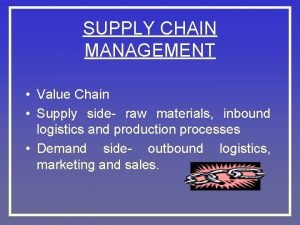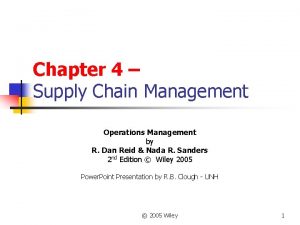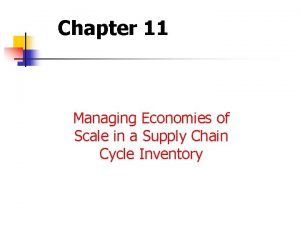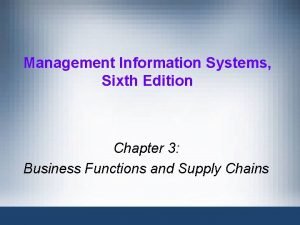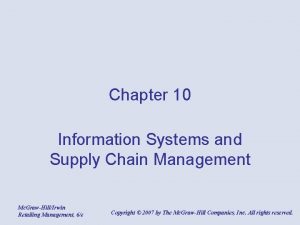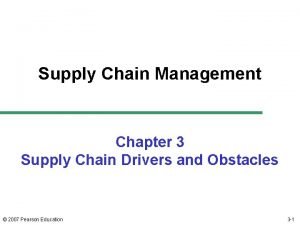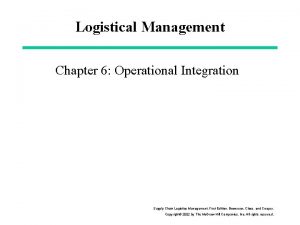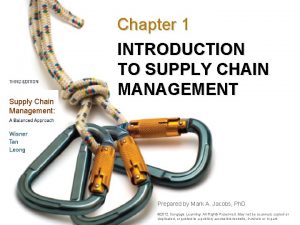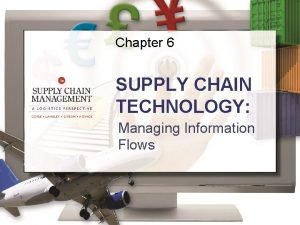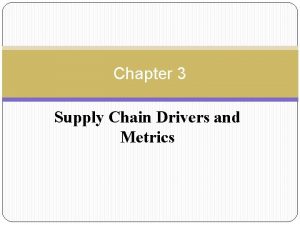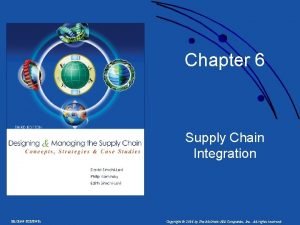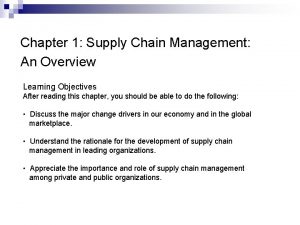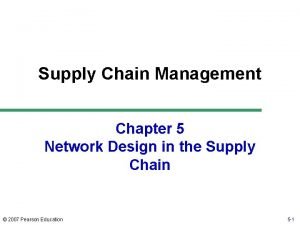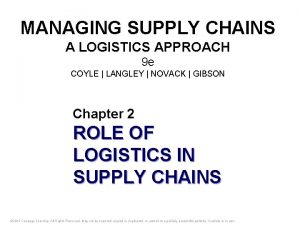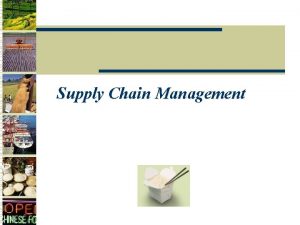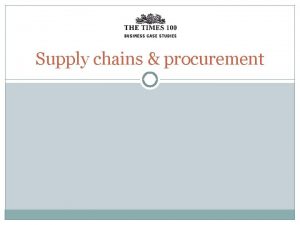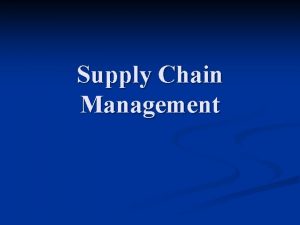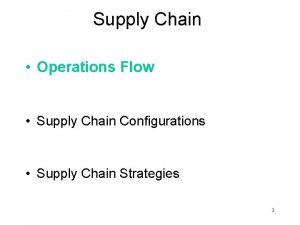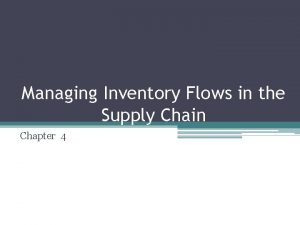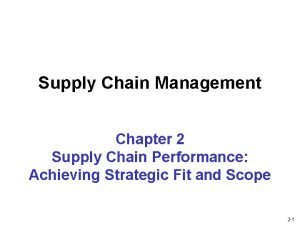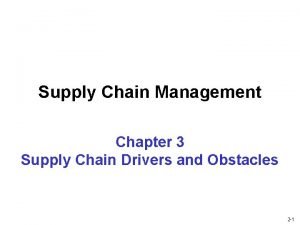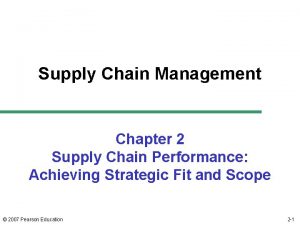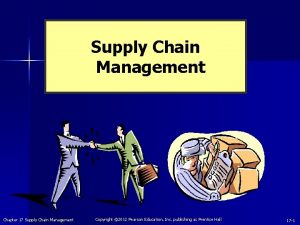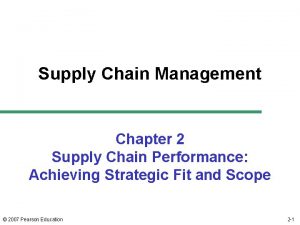CHAPTER 14 Supply Chain Technology Managing Information Flows





















- Slides: 21

CHAPTER 14 Supply Chain Technology: Managing Information Flows Supply Chain Management: A Logistics Perspective (10 e) Coyle, Langley, Novack, and Gibson © 2016 Cengage Learning. All Rights Reserved. May not be scanned, copied or duplicated, or posted to a publicly accessible website, in whole or in part.

Discussion Outline Ù Information Ù Systems Ù Supply capabilities chain management software Ù Technology Ù Supply requirements selection chain technology innovations © 2016 Cengage Learning. All Rights Reserved. May not be scanned, copied or duplicated, or posted to a publicly accessible website, in whole or in part. 2

Information Requirements Ù Information connects the extended supply chain, providing cross-chain insights regarding demand, customer orders, delivery status, inventory stock levels, and production schedules. Ù Three principle supply chain information requirements: ÷ Meet quality standards ÷ Support multidirectional flows ÷ Provide decision support Source: Figure 14 -1 © 2016 Cengage Learning. All Rights Reserved. May not be scanned, copied or duplicated, or posted to a publicly accessible website, in whole or in part. 3

Information Requirements (continued) Support Multidirectional Flows Meet Quality Standards Seven information quality standards: Ù Accuracy Ù Accessibility Ù Relevancy Ù Timeliness Ù Transferability Ù Usability Ù Reliability Internal information sharing Ù External information sharing ÷ Suppliers ÷ Logistics service providers ÷ Financial institutions ÷ Government agencies Ù Provide Decision Support Strategic decisions: Longrange supply chain plans Ù Tactical planning: Crossorganization linkages and supply chain activity coordination. Ù Routine decisions: Rulesbased decision making. Ù Execution and transaction processing: Completion of fulfillment activities Ù © 2016 Cengage Learning. All Rights Reserved. May not be scanned, copied or duplicated, or posted to a publicly accessible website, in whole or in part. 4

Systems Capabilities Enable Process Excellence Link Network Elements Mitigate Technology Risks

Systems Capabilities Enable Process Excellence The system must facilitate excellent performance across the plan, buy, make, move, and return processes of a supply chain. 7 6 Optimization Crosschain visibility 2 Adaptability 4 Velocity Synchronization 3 Supports process variability reduction, performance optimization, & cost control. 2 Support analytics that help to understand volatility and respond appropriately. 3 Agility Segmentation 5 1 1 Adjust speeds according to situations. 4 Facilitates data synchronization & real-time information sharing between partners. 5 Enable strategic adaptation of supply chain design & capabilities to evolving conditions. 6 Help define customer segments, understand cost to serve & prioritize service execution. 7 Enable consideration of trade-offs, effectively deploy resources, & make decision. © 2016 Cengage Learning. All Rights Reserved. May not be scanned, copied or duplicated, or posted to a publicly accessible website, in whole or in part. 6

Systems Capabilities Link Network Elements A cohesive network of integrated technologies, skilled people, and robust processes must be established. Source: Figure 14 -2 © 2016 Cengage Learning. All Rights Reserved. May not be scanned, copied or duplicated, or posted to a publicly accessible website, in whole or in part. 7

Systems Capabilities Mitigate Technology Risks Common risks must be identified and mitigated to maximize the return on technology investments. The pitfalls associated with systems adoption or upgrades Ù Unrealistic assumption that supply chain technologies will readily solve or fix flawed supply chains. Ù Weak technology-process alignment, leading to illfitting solutions that fail to achieve their promise Ù Technology gaps as a result of piecemeal purchases and deployment of technologies Ù Challenges in cross-chain systems integration with suppliers, service providers, and customers Ù Poor planning and preparation for technology implementation © 2016 Cengage Learning. All Rights Reserved. May not be scanned, copied or duplicated, or posted to a publicly accessible website, in whole or in part. 8

Supply Chain Management (SCM) Software

SCM Software Four Software Categories Source: Figure 14 -3 © 2016 Cengage Learning. All Rights Reserved. May not be scanned, copied or duplicated, or posted to a publicly accessible website, in whole or in part. 10

SCM Software: Planning Applications SCM planning applications help organizations shift from autonomous planning activities to synchronized planning processes that use realtime data for collaboration across departments, suppliers & customers. Available/capable to promise Sales and operations planning/integrated business planning Production/multiplant capacity planning Production/factory planning and scheduling Collaborative planning, forecasting, and replenishment Vendor-managed inventory/direct point of sale Event planning (promotion, life cycle) Distribution planning Demand planning Strategic network design Supply planning Inventory strategy optimization Inventory planning Source: Table 14 -1 © 2016 Cengage Learning. All Rights Reserved. May not be scanned, copied or duplicated, or posted to a publicly accessible website, in whole or in part. 11

SCM Software: Execution Applications Companies deploy a variety of execution software to facilitates desired performance of day-to-day operating tasks required to support customer demand. Warehouse Management Systems Inventory management Labor management Order processing Yard/dock management Returns management Transportation Management Systems Mode and carrier selection Route planning and optimization Dispatching and scheduling Freight audit and payment Performance analysis Order Management Systems Global Trade Management Sales order entry Pricing and credit checks Inventory allocation Invoice generation Distributed Order Management Order assignment Trade compliance International logistics Global order management Global trade financial management Manufacturing Execution Systems Work-in-process management Source: Table 14 -2 © 2016 Cengage Learning. All Rights Reserved. May not be scanned, copied or duplicated, or posted to a publicly accessible website, in whole or in part. 12

SCM Software: Event Management Tools Supply chain event management tools collect data in real time from multiple sources across the network and convert them into information that allows companies to automate the monitoring of supply chain events as they occur on a day-to-day basis. Provide the cross-chain visibility needed to detect, evaluate, and adapt to changing conditions before they snowball into major problems. Built-in work flow rules initiate automated responses that are either preemptive or reactive. Integrated into other applications, event management solutions help to close the loop between planning and execution to support synchronization of endto-end activities. © 2016 Cengage Learning. All Rights Reserved. May not be scanned, copied or duplicated, or posted to a publicly accessible website, in whole or in part. 13

SCM Software: Business Intelligence Tools BI Capabilities The data collection & “big data” analytics Self-service reporting Performance scorecarding versus goals Development of graphical dashboards Activity monitoring supporting event mgnt. Access to data residing on multiple SCIS BI Opportunity Areas Generating valuable insights about complex global operations Ù Providing more granular visibility of spending Ù Improving S&OP & demand forecasting Ù Resolving logistics bottlenecks Ù © 2016 Cengage Learning. All Rights Reserved. May not be scanned, copied or duplicated, or posted to a publicly accessible website, in whole or in part. 14

SCM Software: Facilitating Tools Facilitating systems and applications provide critical links between supply chain processes, the organization, and external stakeholders. Collectively, they create a holistic view of the supply chain. Enterprise resource planning (ERP) systems • Incorporate internal and external systems into a single unified solution that spans the enterprise. Supplier relationship management (SRM) • A controlled and systematic approach to managing an organization’s sourcing activities for goods and services. Customer relationship management (CRM) • Focuses on practices, strategies & technologies used to manage and analyze customer interactions & data throughout relationship lifecycle Automatic identification (auto-ID) & data capture technologies • Recognize objects, collect relevant information, and feed the data directly into the SCIS. © 2016 Cengage Learning. All Rights Reserved. May not be scanned, copied or duplicated, or posted to a publicly accessible website, in whole or in part. 15

SCM Technology Implementation

SCM Technology Implementation The key to harnessing the capabilities of supply chain technology within a reasonable time frame is informed decision making, with a clear vision regarding how technology spending will facilitate supply chain strategy and satisfy specific requirements. 3 Mitigate Implementation Issues 2 Need Assessment 1 Understand the supply chain that the technology is intended to support. 2 A multifaceted decision, involving development alternatives (off the shelves vs. in-house), types of applications (individual applications vs. integrated suite), and purchase options (on-premise vs. Saa. S) 3 Training, cultural change, systems interoperability, data synchronization, data standardization, and application integration 1 Software Selection © 2016 Cengage Learning. All Rights Reserved. May not be scanned, copied or duplicated, or posted to a publicly accessible website, in whole or in part. 17

SCM Technology Implementation 10 Golden Rules for Success 1 Secure commitment of senior management. 6 Follow a proven implementation methodology. 2 Remember that it is not just an information technology project. 7 Take a step-by-step approach for incremental value gains. Align the project with business goals. 8 Be prepared to change business processes. Understand the software capabilities. 9 Keep end users informed and involved. 10 Measure success with key performance indicators (KPIs). 3 4 5 Select partners carefully. © 2016 Cengage Learning. All Rights Reserved. May not be scanned, copied or duplicated, or posted to a publicly accessible website, in whole or in part. 18

Supply Chain Technology Innovations

Supply Chain Technology Innovations Internet of Things (Io. T) Ù Connected devices, with sensors, on/off switches, & Internet linkages, allowing intelligent connection of people, processes, data, and equipments. Mobile Connectivity Ù Advancements in GPS technology, auto-ID, wireless connectivity, tablets, and smartphones improve visibility, asset control, and agility of supply chain. Functional Automation has long been a part of the manufacturing plant. Ù Warehouse automation has gained tremendous traction. Ù Connective technologies needed to support driverless vehicles are under rapid development. Ù Images courtesy of Aria Systems, Eric D. Brown, Fathom © 2016 Cengage Learning. All Rights Reserved. May not be scanned, copied or duplicated, or posted to a publicly accessible website, in whole or in part. 20

Summary Ù To produce actionable knowledge, supply chain information must be high quality, readily flow between organizations, and support a variety of decision types. Ù A well-designed SCIS links people, processes, and technology in a manner that provides actionable information and enhances decision making. Ù four general categories of supply chain software are: (1) planning tools forecasting and related activities, (2) execution systems for management of day-to-day processes, (3) event management tools to monitor supply chain flows, and (4) business intelligence applications used to analyze performance. Ù To maximize SCIS investment success, managers must effectively assess the SCM requirements, understand software options, and address the technical issues.
 4 flows of supply chain
4 flows of supply chain Operations management chapter 4
Operations management chapter 4 A key to reducing lot size without increasing costs is to
A key to reducing lot size without increasing costs is to Managing economies of scale in a supply chain
Managing economies of scale in a supply chain Role of safety inventory in supply chain
Role of safety inventory in supply chain Managing economies of scale in a supply chain
Managing economies of scale in a supply chain Matching supply with demand
Matching supply with demand Information technology resource
Information technology resource Difference between logistics and supply chain
Difference between logistics and supply chain Food chain sequence
Food chain sequence Supply chain information system
Supply chain information system Information system and supply chain management in retailing
Information system and supply chain management in retailing Chapter 5 section 1 supply and the law of supply
Chapter 5 section 1 supply and the law of supply Drivers in supply chain
Drivers in supply chain The great divide supply chain management
The great divide supply chain management Chapter 1 supply chain management
Chapter 1 supply chain management Chapter 6 supply chain management
Chapter 6 supply chain management Drivers of supply chain management
Drivers of supply chain management Chapter 6 supply chain management
Chapter 6 supply chain management Chapter 1 supply chain management
Chapter 1 supply chain management Tailored network in supply chain
Tailored network in supply chain Managing supply chains a logistics approach
Managing supply chains a logistics approach
